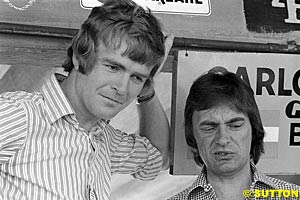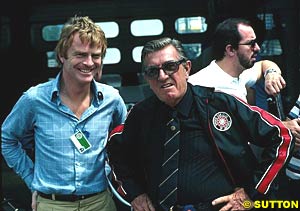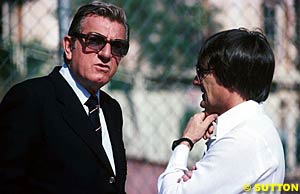
Atlas F1 Columnist
With recent events suggesting Formula One might see another power struggle between the governing body and the sport's participants, it is perhaps worthy having a look at what happened the last time around, and how miniscule today's battles are compared to that Great Big War. In the upcoming weeks, Atlas F1's Don Capps will recount the war that became known since as The FIASCO WAR, and how it completely changed the face of Formula One. This week: the events leading up to the battle
The answer, in a nutshell, is what became known since as The FISA/FOCA War, or in short: The FIASCO War.
The conflict escalated into open warfare in the Summer of 1980. Naturally, the true origin is perhaps forever lost to the mists of history, but one event which played a role occurred in May 1972. It concerned an issue which usually rests at the bottom of all such conflicts - money; and its usual associate - power. From its formation in November 1964, FOCA began to exercise more and more influence on how things were run in the world of Grand Prix racing. Although some steps had been taken prior to the formation of FOCA to standardize such issues of importance as starting monies, the constructors rarely worked in unison. This generally helped the organizing clubs.
Once the FOCA began to flex its muscle, the Commission Sportive Internationale (CSI) - the previous incarnation of FISA - was generally not inclined to exert either much discipline or direction to counter-balance the FOCA. The drivers often worked in parallel with the FOCA through the Grand Prix Drivers Association (GPDA), but there were some natural frictions between the GPDA and the FOCA which were generally minimized - at least in public.
For the 1972 season, the FOCA had engineered a standard agreement with the organizing clubs which set the size of the field for a Grand Prix championship event at 25 cars. That is, with one exception - Monaco. For Monaco, the field was set at 20. The FOCA stated that this was unsatisfactory, and to make its dissatisfaction clear, the FOCA teams refused to take the track for the practice session until the number of cars in the field was increased to 25. This caught the new president of the Automobile Club of Monaco, Michel Boeri, by surprise. Boeri pointed out that there was a CSI regulation which set the size of the field in the principality at 20 - paragraph B of Article 4, to be exact.
Boeri said that only the CSI could change a CSI regulation, but unfortunately for him, the AC de Monaco had verbally agreed with the FOCA to allow 25 starters two weeks previously. The teams had arrived expecting to field 25 cars only to find that the grid would be only 20 cars, hence the refusal to allow their cars to practice. The FOCA had arrived and expected the AC de Monaco to abide by the standard agreement - the starting monies as determined by the Geneva Scale, the passes, and other stipulations. Indeed, the FOCA management had a telegram from the CSI okaying the new number of starters.
It has to be appreciated just how confusing and complicated and convoluted all this was. The FOCA thought it had a done deal with the AC de Monaco and the CSI. To show up and suddenly find that that deal seemed to have been forgotten got more than a few FOCA members into a low hover with their target acquisition radars set at max. The CSI president, Prince Metternich, was not on the scene so the director of the French national auto sporting authority (the FFSA - Federation Francaise du Sport Automobile) and the French CSI representative, Jacques Blanchet, stepped into the breach to attempt to resolve the issue. Meanwhile Prince Metternich, in Paris, held a press conference and guided the discussion in the direction of other issues which were perhaps the "real" reason behind the decision by the FOCA to be difficult - the safety changes already enacted and those coming for the 1973 season.
After much maneuvering and not a little hardnosed negotiating by the FOCA, Blanchet and Boeri agreed to the FOCA demand for 25-car grid. The FOCA had flexed its muscle and the CSI and the AC de Monaco came off looking like losers. This did not go over well in some quarters, especially in light of the fact that Blanchet stated that the CSI lacked the power to enforce the "only 20 cars for Monaco" provision. Needless to say, Blanchet was a casualty of this incident. An interested observer to all this was a successor to Blanchet as the director of the FFSA - Jean-Marie Balestre.
In late 1972, the FOCA and GPI were in the throes of hammering out the terms for the 1973 season. GPI said not a penny over £53,000 per weekend, while in contrast the FOCA was asking for not a penny less than £103,000 a weekend. GPI gave the FOCA a "take-it-or-leave-it" demand, with a deadline of mid-December. Storm clouds were brewing and lightning crackled at a right dangerous pace as GPI and FOCA glared at each other. To assure unity within its ranks, each member of GPI posted a hefty bond to be forfeited if someone bolted. The FOCA was standing pat because it felt that its trump card was the fact that it "owned" the drivers.
Meanwhile, the CSI looked on with a benign smile after earlier stating that the formation of GPI would result in a more stable situation in the Grand Prix world. Prince Metternich was still basking in the glow of his achievement as a negotiator when the bargaining chips were set at 400,000SF and 438,000SF and he brokered a compromise of 420,000SF. Prince Metternich and the CSI completely missed the fact that the whole game was different this time. The CSI was clearly opting to support the GPI and the FOCA were taking careful note of this fact and how to use it when the fight broke out.
Although GPI voiced the opinion that their offer of 475,000SF was more than fair and represented over a 12% increase from the previous year and that the prize monies offered were more than adequate to offset the demands of the FOCA, the FOCA shot back with a withering message that while the costs of the cars and engines had jumped in the neighborhood of 300% and 600% respectively, the prize monies were the same as they had been in the 1959-1960 period.
As the FOCA dug in its heels, GPI petitioned the CSI for permission to run the events counting towards the World Championship for cars conforming to F1, Formula 5000, the USAC Championship Car formula, and F2. The CSI granted the GPI clubs permission to do so. Both the FOCA and the GPDA questioned the safety of such an action, particularly with the first World Championship event - the Argentinean Grand Prix - little more than a month away.
Then the GPI coalition began to unravel. Those overseas clubs which shouldered the financial costs of transporting the teams to their races had to deal with the FOCA teams concerning those costs. The Argentine club had not joined GPI, so was not really an issue, particularly since it was basically aligned with the GPI principles. However, the travel agreements for the South African race were still being negotiated. This meant that the FOCA had at least two events more or less lined up with it.
The FOCA then dropped one of its trump cards on the table. When the CSI had stepped in at Monaco, it had announced a new set of safety regulations to take effect with the first European event on the calendar, the Spanish Grand Prix. The FOCA asked the question if the announced safety regulations were still set to go into effect with the Spanish race. It also wondered aloud that after making such an issue of safety why was it that the CSI was now willing to allow the fielding of cars which would not meet these new regulations? Was the safety issue merely a canard?
Treu, however, did have an inspired idea and approached Enzo Ferrari asking for his help. By this time, the FOCA was already ahead of Treu. Ferrari was not exactly fond of the FOCA, but he also knew a losing hand when he saw one. Treu suddenly had to face the reality that he and GPI had been defeated, and badly, by the FOCA. GPI simply withered away and disappeared. It was clear that the FOCA was the big kahuna on the block. And, by casting its lot with GPI, the CSI was damaged even more in the credibility department.
In 1976, Prince Metternich declined to run once more for the presidency of the CSI. He was replaced by Pierre Ugeux, a Belgian. Like Metternich, Ugeux had his fun-meter pegged after dealing with the FOCA for only two years. In the breach stepped the director of the FFSA, Jean-Marie Balestre. Balestre assumed the presidency of the CSI in late 1978. One of his first acts was to rename the CSI - it was now the FISA. In this manner Balestre began a series of steps with which he began to shift the FISA from a FOCA patsy into an organization ready, willing, and able to do battle with the FOCA, if necessary.
There is a fundamental law in physics which clearly states that two objects cannot occupy the same space at the same time, the result of trying to do so rendering forth a great noise and much debris. This also applies to politics. In 1979 the FISA, with Balestre at the helm, was moving to exert its power against the FOCA, which held the reins thereof, and had no intention to turn them over anybody, the FISA in particular. It was not a question of whether or not there would be a confrontation, simply a matter of when and over what.
The debut of "ground effects" in the form of the Lotus 78 and 79 proved to be the spark which was to cause the showdown between the FISA and the FOCA to come to blows. There were a few warning shots early in the 1979 season that things were going to be different with Balestre at the helm of the FISA. Bernie Ecclestone had moved into the leadership position and lead spokesman of the FOCA at this time. They would not have much of a honeymoon period to get the measure of one another: Balestre determined that John Watson was the culprit responsible for a big shunt at the start of the Argentinean Grand Prix which left five of the original starters on the sideline and unable to participate in the second start. Watson was fined 10,000SF by the FISA, an act which seemed calculated to get the FOCA into a low hover.
As the 1979 season rolled on, Balestre became more and more vocal about the state of Grand Prix racing. In turn, the FOCA was facing the unpleasant fact that turbocharging was apparently here to stay, although they were not deterred by that thought when it came to voicing its opinion about the state of Grand Prix racing. It was apparent that two objects were getting ready to occupy the same space and at the same time. Even the Untrained Eye could see trouble brewing. Soon many were to learn that FISA + FOCA = FIASCO.
To be continued next week...
Do you know who won the 1980 Spanish Grand Prix? Can you name the winner of the 1981 South African Grand Prix? By all means, if you're new to the sport or simply can't remember, consult one of those books or web sites containing statistics on the World Drivers' Championship or Formula One. What? These events are not listed? Any idea as to why?
 The FIASCO War was not the first struggle to mar the racing scene, but it has certainly been one of those pivotal events, much like the American War of the Rebellion or the Second World War. The FIASCO War saw the Federation Internationale de Sport Automobile, FISA, and the Formula One Constructors Association, FOCA, collide head-on into each other in 1980. It was an ugly, nasty period for racing, made more dismal with the on-going battles between the United States Auto Club (USAC) and the Championship Auto Racing Teams (CART) in the United States.
The FIASCO War was not the first struggle to mar the racing scene, but it has certainly been one of those pivotal events, much like the American War of the Rebellion or the Second World War. The FIASCO War saw the Federation Internationale de Sport Automobile, FISA, and the Formula One Constructors Association, FOCA, collide head-on into each other in 1980. It was an ugly, nasty period for racing, made more dismal with the on-going battles between the United States Auto Club (USAC) and the Championship Auto Racing Teams (CART) in the United States.
 After the 1972 Monaco race and in preparation for the 1973 season, the organizing clubs formed their own association, Grand Prix International (GPI), to redress what they considered to be an imbalance in the power between the participants in the Grand Prix business. The basic purpose of GPI was to take the FOCA down a few notches. GPI was intended to serve as the representative of the hosting clubs when it came to negotiating the contract with the FOCA for what a weekend would "cost." During 1972, there had been minor skirmishes during the season between FOCA and the hosting clubs over money.
After the 1972 Monaco race and in preparation for the 1973 season, the organizing clubs formed their own association, Grand Prix International (GPI), to redress what they considered to be an imbalance in the power between the participants in the Grand Prix business. The basic purpose of GPI was to take the FOCA down a few notches. GPI was intended to serve as the representative of the hosting clubs when it came to negotiating the contract with the FOCA for what a weekend would "cost." During 1972, there had been minor skirmishes during the season between FOCA and the hosting clubs over money.
 The FOCA announced that it was breaking off negotiations with GPI and would now negotiate directly with the individual organizers, as it had with South Africa. The spokesman for the FOCA on this issue was Max Mosley, one of the founders of March, along with the new owner of Brabham, Bernie Ecclestone. This ploy was one which relied on the long established relationships which existed between the constructors and the clubs. By quietly doing an end run on GPI, the powerbase of the organization simply quietly eroded despite the efforts of the spokesman for GPI, Henri Treu.
The FOCA announced that it was breaking off negotiations with GPI and would now negotiate directly with the individual organizers, as it had with South Africa. The spokesman for the FOCA on this issue was Max Mosley, one of the founders of March, along with the new owner of Brabham, Bernie Ecclestone. This ploy was one which relied on the long established relationships which existed between the constructors and the clubs. By quietly doing an end run on GPI, the powerbase of the organization simply quietly eroded despite the efforts of the spokesman for GPI, Henri Treu.
Please Contact Us for permission to republish this or any other material from Atlas F1.
|
Volume 9, Issue 4
Atlas F1 Special
Renault in Formula One: Take Two
Back to the Future: The FIASCO War
Articles
Battle at BAR
Columns
Bookworm Critique
Rear View Mirror
Elsewhere in Racing
The Grapevine
> Homepage |